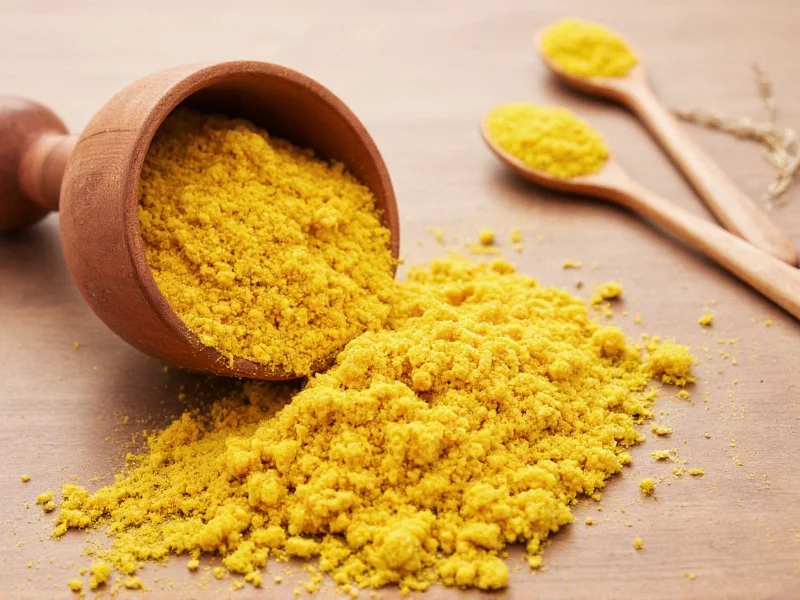The best substitutes for dry mustard are: 1) Prepared mustard (use 1 tablespoon prepared mustard for every 1 teaspoon dry mustard, reducing other liquids), 2) Mustard seeds (grind 1.5 teaspoons seeds for 1 teaspoon dry mustard), 3) Horseradish (1 teaspoon for 1 teaspoon dry mustard, but adds heat), or 4) A blend of turmeric and vinegar (1/2 teaspoon turmeric + 1/2 teaspoon vinegar for 1 teaspoon dry mustard). The ideal replacement depends on your specific recipe and desired flavor profile.
Understanding Dry Mustard's Role in Cooking
Dry mustard, also called mustard powder, provides a distinctive tangy, slightly spicy flavor that enhances sauces, dressings, marinades, and baked goods. Unlike prepared mustard, it contains no liquid, making it perfect for dry rubs and recipes where moisture control matters. When you're out of dry mustard, understanding its function helps you choose the best substitute.
Chef Maria Rodriguez, who has developed recipes for major culinary publications for 15 years, explains: "Dry mustard's magic lies in its ability to emulsify ingredients while adding complex flavor without altering texture. The right substitute maintains this balance while working within your recipe's constraints."
Top Substitutes for Dry Mustard
Prepared Mustard
This is the most accessible dry mustard substitute for most home cooks. Prepared mustard contains vinegar, water, and sometimes sweeteners that dry mustard lacks.
Conversion ratio: Use 1 tablespoon prepared mustard for every 1 teaspoon of dry mustard called for in your recipe. Since prepared mustard adds liquid, reduce other liquids in your recipe by 2 teaspoons for each substitution.
Best for: Salad dressings, cheese sauces, marinades, and meat glazes. Dijon mustard works particularly well as a dry mustard substitute in creamy sauces.
Mustard Seeds
Whole mustard seeds can be ground into a powder that closely mimics dry mustard's flavor profile. Yellow mustard seeds provide the mildest flavor, while brown or black seeds offer more heat.
Conversion ratio: Grind 1.5 teaspoons of mustard seeds to replace 1 teaspoon of dry mustard. For immediate use, mix ground seeds with a few drops of warm water and let sit for 5 minutes to activate enzymes.
Best for: Pickling recipes, spice rubs, and homemade mustard where texture isn't critical.
Horseradish
While not identical, horseradish shares mustard's pungent quality. Use it when you need that sharp bite but can accommodate additional heat.
Conversion ratio: Substitute 1 teaspoon prepared horseradish for 1 teaspoon dry mustard. Add a pinch of turmeric for color approximation if desired.
Best for: Bloody Mary mixes, roast beef accompaniments, and recipes where extra heat complements other flavors.
Turmeric and Vinegar Blend
This combination approximates dry mustard's color and some flavor elements when you have no mustard products available.
Conversion ratio: Mix 1/2 teaspoon turmeric with 1/2 teaspoon vinegar (white or apple cider) to replace 1 teaspoon dry mustard.
Best for: Emergency substitutions in cheese sauces or salad dressings where exact flavor isn't critical.
Dry Mustard Substitution Guide by Recipe Type
| Recipe Type | Best Substitute | Adjustments Needed | Flavor Impact |
|---|---|---|---|
| Cheese Sauce | Prepared mustard (Dijon) | Reduce milk by 1 tbsp per tsp substituted | Nearly identical flavor, slightly tangier |
| Dry Rubs | Mustard seeds (ground) | None needed | Slightly more intense, authentic mustard flavor |
| Salad Dressings | Prepared mustard | Reduce oil by 1 tsp per tbsp used | Enhanced emulsification, slightly stronger flavor |
| Baking (Savory) | Turmeric + vinegar blend | None for dry ingredients | Milder flavor, similar color |
| Meat Marinades | Horseradish | Add 1/4 tsp sugar to balance heat | More pungent, adds complexity |
Common Substitution Mistakes to Avoid
Many home cooks make these errors when substituting for dry mustard:
- Ignoring moisture content: Prepared mustard adds liquid that dry mustard doesn't. Always adjust other liquids in your recipe when using wet substitutes.
- Using equal volumes: Mustard seeds need to be ground and activated with liquid to properly replace dry mustard's potency.
- Overcompensating: Start with less substitute than you think you need, then adjust to taste after the dish has cooked.
- Misunderstanding flavor profiles: Wasabi and horseradish provide heat but lack dry mustard's distinctive tang.
Professional Tips for Perfect Substitutions
Experienced chefs recommend these techniques when replacing dry mustard:
- Activate substitutes: Mix ground mustard seeds or turmeric with a few drops of warm water and let sit for 5 minutes before adding to your recipe. This activates enzymes that develop flavor.
- Balance acidity: If using vinegar-based substitutes, add a pinch of sugar to balance the increased acidity.
- Layer flavors: For complex dishes, combine two substitutes (like a small amount of horseradish with prepared mustard) to approximate dry mustard's multidimensional flavor.
- Taste as you go: Add substitute gradually, especially when using stronger options like horseradish.
Creating Your Own Dry Mustard Substitute Blend
For frequent cooking needs, create a homemade dry mustard replacement that keeps in your spice cabinet:
Mix together: 2 tablespoons ground yellow mustard seeds, 1 tablespoon turmeric, 1 teaspoon garlic powder, and 1/2 teaspoon paprika. Store in an airtight container for up to 3 months. Use 1 teaspoon of this blend to replace 1 teaspoon of commercial dry mustard.
This versatile dry mustard alternative works well in most recipes calling for dry mustard and provides consistent results. The added spices help compensate for flavor variations between commercial dry mustard brands.











 浙公网安备
33010002000092号
浙公网安备
33010002000092号 浙B2-20120091-4
浙B2-20120091-4